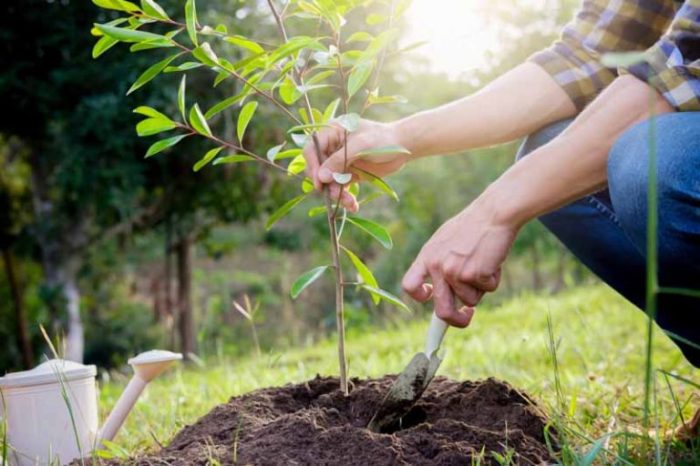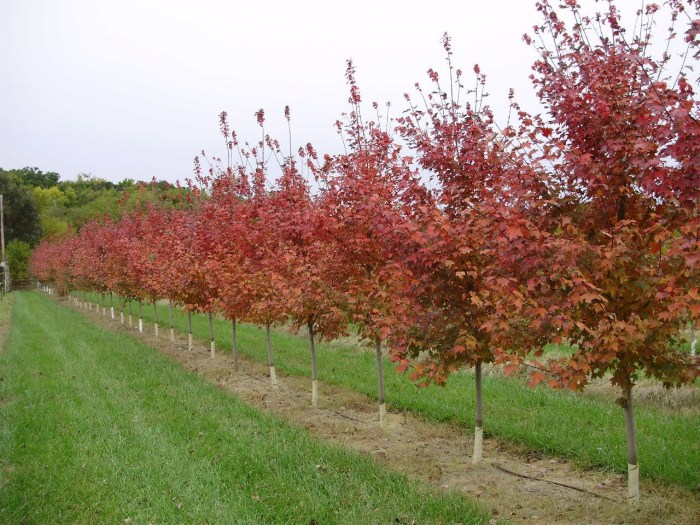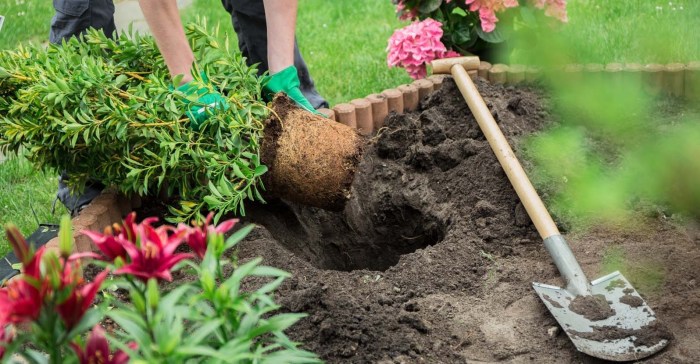Best Trees for Fall Planting: Trees You Can Plant In The Fall
Trees you can plant in the fall – Fall is the perfect time to plant trees. The cooler temperatures and moist soil create an ideal environment for root establishment before the winter freeze. This allows trees to become more resilient and better prepared for the challenges of the upcoming growing season. Choosing the right tree for your space and climate is crucial for success. Let’s explore some excellent options for fall planting, categorized by size.
Optimal Tree Species for Fall Planting
Planting trees in the fall offers several key advantages. The soil is typically moist from the autumn rains, reducing the need for frequent watering. Furthermore, the cooler temperatures slow down the rate of transpiration, meaning the tree doesn’t lose as much water through its leaves. This combination leads to better root development and a higher survival rate compared to spring planting.
The dormant period of the tree during winter also allows it to focus its energy on root growth and establishing a strong foundation.
| Name | Size | Fall Color | Growing Conditions |
|---|---|---|---|
| Red Maple (Acer rubrum) | Medium to Large | Brilliant red, orange, and yellow | Adaptable to various soil types, prefers moist, well-drained soil; tolerates full sun to partial shade. |
| Sugar Maple (Acer saccharum) | Large | Golden yellow to orange-red | Prefers well-drained, slightly acidic soil; thrives in full sun. |
| Oak (Quercus spp.) | Large | Brown, reddish-brown | Prefers well-drained soil; tolerates a wide range of soil pH; full sun to partial shade. Different oak species have varying needs. |
| American Hornbeam (Carpinus caroliniana) | Medium | Yellow to golden brown | Prefers moist, well-drained soil; tolerates partial shade. |
| Japanese Maple (Acer palmatum) | Small to Medium | Fiery reds, oranges, and yellows (varies by cultivar) | Prefers well-drained, slightly acidic soil; partial shade is ideal. |
| Serviceberry (Amelanchier spp.) | Small to Medium | Red, orange, yellow | Adaptable to various soil types; tolerates full sun to partial shade. |
| Crabapple (Malus spp.) | Small to Medium | Red, orange, yellow, or purple (varies by cultivar) | Prefers well-drained soil; full sun to partial shade. |
| Birch (Betula spp.) | Medium to Large | Yellow, gold | Prefers moist, well-drained soil; full sun to partial shade. Different birch species have varying needs. |
| Dogwood (Cornus spp.) | Small to Medium | Red, purple, or orange (varies by species) | Prefers moist, well-drained soil; partial shade to full sun (depending on the species). |
| Hawthorn (Crataegus spp.) | Small to Medium | Orange, red, yellow | Tolerates a wide range of soil types; full sun to partial shade. |
Soil and Climate Considerations for Fall Planting
Successful tree planting hinges on matching the tree’s needs to your specific site conditions. For instance, Red Maples, known for their adaptability, thrive in a wide range of climates and soil types, while Sugar Maples prefer well-drained, slightly acidic soil and a full sun environment. Before planting, it is essential to conduct a soil test to determine its pH and nutrient levels.
This information, coupled with understanding your local climate, will guide you in selecting the most appropriate tree species for long-term success. Ignoring these factors can lead to poor growth or even tree mortality. For example, planting a Sugar Maple in poorly drained, alkaline soil will likely result in a stunted and unhealthy tree.
Preparing the Planting Site

Planting trees in the fall offers a significant advantage: the cooler temperatures and increased rainfall allow for better root establishment before the stress of summer heat arrives. However, maximizing this advantage requires meticulous site preparation. Failing to properly prepare the soil can severely hinder a tree’s growth and even lead to its demise. Let’s explore the critical steps to ensure your fall planting is a resounding success.
Successful fall planting hinges on creating an optimal environment for your new trees. This involves understanding and addressing your soil’s characteristics, ensuring proper drainage, and eliminating competition from weeds and existing vegetation. Think of it as setting the stage for a thriving performance – the better the preparation, the more spectacular the results.
Soil Preparation for Fall Tree Planting
Preparing the soil is paramount. It involves a three-step process: testing, amending, and ensuring proper drainage. First, conduct a soil test to determine its pH level and nutrient composition. This inexpensive test, available from most agricultural extension offices or garden centers, provides crucial insights into your soil’s health. Knowing your soil’s pH allows you to adjust it to the optimal range for the specific tree species you’re planting; most trees prefer a slightly acidic to neutral pH (6.0-7.0).
The test will also reveal any nutrient deficiencies, enabling you to amend the soil accordingly.
Once you have your soil test results, amend the soil as needed. This might involve adding organic matter like compost or well-rotted manure to improve soil structure, drainage, and nutrient content. Sandy soils benefit from the addition of organic matter to increase their water retention capacity, while clay soils need organic matter to improve drainage and aeration. The amount of amendment needed will vary depending on the soil test results; follow the recommendations provided with your soil test report.
For instance, if your soil test reveals a low level of phosphorus, adding bone meal or a phosphorus-rich fertilizer will help address this deficiency. Remember, amending the soil before planting is far more effective than trying to correct deficiencies later.
Ideal Tree Spacing
Proper spacing is crucial for the long-term health and growth of your trees. Overcrowding leads to competition for resources, resulting in stunted growth and weaker trees more susceptible to disease and pests. Imagine a visual representation: a grid showing various tree species with their mature sizes indicated (e.g., a 20-foot-wide oak tree would need a much larger spacing than a 5-foot-wide dogwood).
Each tree’s mature size is labeled, and the recommended spacing between trees of the same species is shown using clear lines, illustrating the necessary distance to prevent overcrowding. For example, a mature oak tree with a 40-foot spread should be planted at least 40 feet away from another oak tree. This visual representation would also show different spacing requirements for different tree sizes and species.
Weed and Plant Removal
Removing competing weeds and plants before planting is essential for several reasons. Weeds compete with young trees for water, nutrients, and sunlight, hindering their establishment and growth. They can also harbor pests and diseases that can infect your newly planted trees. Thoroughly clear the planting area of all weeds and unwanted vegetation, extending the cleared area beyond the immediate planting hole.
This ensures that the young tree has a competitive advantage and can focus its energy on establishing a strong root system rather than fighting for resources with weeds. Consider using a weed barrier fabric in areas where weeds are particularly persistent.
Planting Techniques

Successfully planting a tree in the fall hinges on proper technique. Whether you’re working with a bare-root or container-grown tree, understanding the nuances of planting ensures optimal root establishment and future growth. Failing to plant correctly can lead to stunted growth, stress, and even tree death, undermining your efforts and investment. Let’s explore the best practices for each type of tree.
Planting Bare-Root Trees
Planting bare-root trees requires careful handling to avoid damaging the delicate root system. These trees, typically purchased without soil around their roots, are often more affordable but require extra attention during planting. The goal is to minimize stress on the roots and encourage rapid establishment.
Autumn’s gentle breezes whisper secrets of new beginnings, a perfect time to plant those sturdy saplings that will grace your garden for years to come. Thinking of adding a vibrant citrus splash? Ensure your lemon tree thrives with the right nourishment, perhaps using this excellent lemon tree plant food to give it a head start. Then, watch as your carefully chosen fall plantings flourish, promising a breathtaking spring display.
- Inspect the Roots: Before planting, carefully examine the roots. Prune any broken, damaged, or circling roots with sharp, clean pruning shears. This promotes healthy root growth and prevents girdling.
- Soak the Roots (Optional): Soaking the roots in water for a few hours before planting can help rehydrate them, particularly if they’ve been dry during shipping or storage. This isn’t always necessary, but it can be beneficial, especially for larger trees.
- Dig the Hole: Dig a hole twice as wide and as deep as the tree’s root spread. This allows the roots to spread naturally without being constricted. Avoid planting the tree too deeply; the root flare (where the trunk widens at the base) should be slightly above ground level.
- Position the Tree: Gently place the tree in the hole, ensuring the roots are spread out naturally. Avoid bending or cramming them. The tree should stand upright and stable.
- Backfill the Hole: Gradually backfill the hole with soil, gently firming it around the roots to eliminate air pockets. Avoid compacting the soil too tightly, as this can restrict root growth.
- Water Thoroughly: Water the newly planted tree deeply and slowly to settle the soil and encourage root contact. A slow, deep watering is far more effective than a quick, shallow one.
- Mulch (Optional): Applying a layer of mulch around the base of the tree (but not touching the trunk) helps retain moisture, suppress weeds, and regulate soil temperature.
Planting Container-Grown Trees, Trees you can plant in the fall
Container-grown trees, with their established root ball, are generally easier to plant than bare-root trees. However, improper handling can still lead to problems. The key is to avoid damaging the root ball and ensure the roots have room to grow.
- Inspect the Root Ball: Check the root ball for circling roots. If present, gently loosen them with your fingers or a small tool. Circling roots can severely restrict growth.
- Prepare the Hole: Dig a hole slightly larger than the root ball. The hole should be deep enough to accommodate the root ball without burying the tree too deeply.
- Remove the Container: Carefully remove the tree from its container. If the root ball is tightly bound, gently loosen the sides of the container to release it. Avoid pulling on the trunk.
- Position the Tree: Place the tree in the hole, ensuring the top of the root ball is level with the surrounding ground. Do not plant it too deep.
- Backfill and Water: Backfill the hole with soil, gently firming it around the root ball. Water thoroughly to settle the soil and remove air pockets.
- Mulch (Optional): Apply a layer of mulch around the base of the tree, keeping it away from the trunk.
Bare-Root vs. Container-Grown: Fall Planting Considerations
While both bare-root and container-grown trees can be successfully planted in the fall, there are distinct advantages and disadvantages to consider.
| Feature | Bare-Root | Container-Grown |
|---|---|---|
| Cost | Generally less expensive | Generally more expensive |
| Root System | Requires careful handling; potential for root damage | Established root ball; less susceptible to root damage |
| Establishment | May require more time to establish | Generally establishes more quickly |
| Transportation | Easier to transport, especially for larger trees | Can be more challenging to transport, especially for larger trees |
| Fall Planting Suitability | Well-suited for fall planting, given proper handling and dormancy | Also well-suited for fall planting, offering a quicker establishment period |
Fall Tree Planting Illustrations

Visual aids are crucial for understanding the nuances of successful fall tree planting. A picture truly is worth a thousand words when it comes to mastering proper techniques and avoiding costly mistakes. Let’s examine key illustrations that will solidify your understanding.
Correct Tree Planting Technique
Imagine a detailed cross-section illustration showing a tree being planted. The hole is dug twice as wide as the root ball but only as deep. The tree’s root flare – the point where the trunk widens into the roots – is clearly visible, sitting at or slightly above ground level. The roots are spread naturally within the hole, not bunched or circling.
The backfilled soil is gently tamped, ensuring good root-to-soil contact. No amendments, such as fertilizer, are added to the backfill. Finally, a generous ring of mulch, several inches deep but pulled away from the trunk, encircles the tree, helping retain moisture and suppress weeds. This illustration emphasizes the natural, unconstrained positioning of the roots and the crucial role of proper soil contact and mulch application.
Mature Tree in the Landscape
Picture a majestic oak, its branches reaching high into the sky, casting a dappled shade on the lawn below. The tree stands proudly, its mature size (perhaps 50 feet tall and 40 feet wide) evident in its substantial trunk and expansive canopy. The surrounding landscape complements the tree’s presence, with carefully placed smaller shrubs and flowering plants at its base.
The overall aesthetic is one of balanced growth and natural harmony. The scene depicts a tree that has been properly planted and cared for, illustrating the long-term benefits of autumn planting. This visual shows how a carefully chosen and correctly planted tree can become a striking focal point in any landscape design, enhancing its overall beauty and value.
The mature size is realistically depicted, demonstrating the potential growth of the tree over many years.
Common Fall Tree Planting Mistakes
This illustration shows two contrasting scenarios. The first depicts a tree planted too deeply, its root flare buried under several inches of soil. The trunk appears constricted, and the roots are suffocated. The second shows a tree with improperly applied mulch, piled high against the trunk, creating a breeding ground for disease and pests. The mulch is not only blocking air circulation around the trunk but also potentially damaging the bark.
Both images highlight the negative consequences of these common mistakes: stunted growth, increased susceptibility to disease, and even eventual tree death. This visual comparison powerfully illustrates the importance of following proper planting techniques to ensure the tree’s long-term health and vitality.
User Queries
What is the ideal time for fall tree planting?
The ideal time varies depending on your geographic location and specific tree species, but generally, it’s best to plant after the first frost but before the ground freezes solid.
How deep should I plant a tree?
The top of the root ball or root flare should be level with the surrounding soil. Planting too deep can suffocate the roots.
How often should I water newly planted trees in the fall?
Water deeply and infrequently, ensuring the soil is consistently moist but not waterlogged. The frequency depends on rainfall; supplemental watering may be necessary during dry spells.
What are some common fall tree pests and diseases?
Common issues include leaf spot diseases, aphids, and borers. Regular inspection and preventative measures, such as proper sanitation and insecticide application if needed, are recommended.
